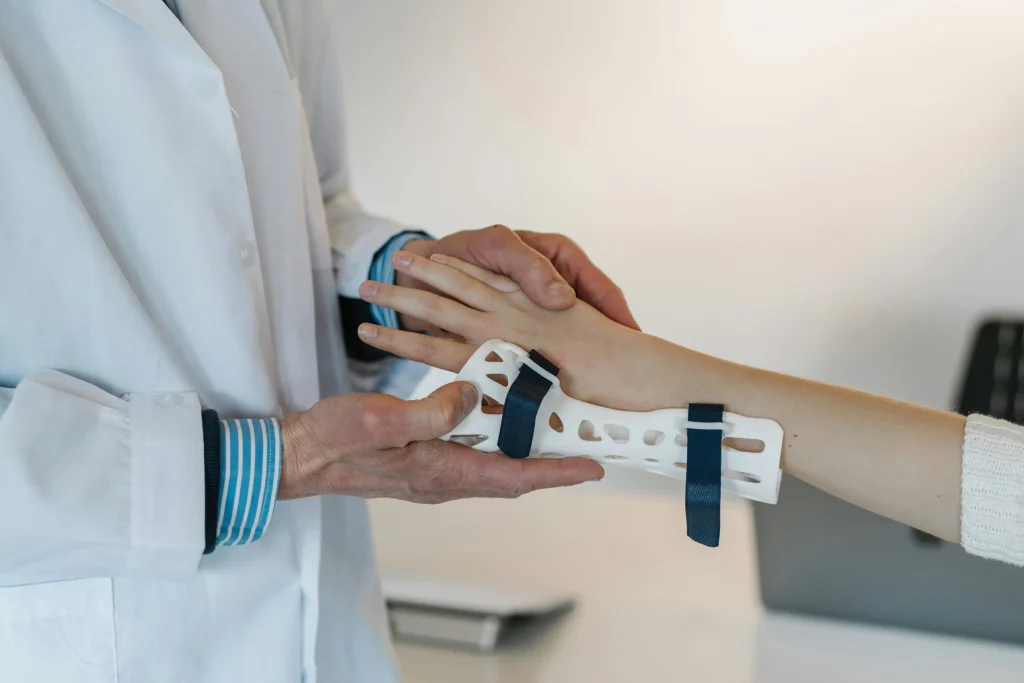Treatment of wrist arthrosis
Introduction to wrist osteoarthritis
Wrist osteoarthritis is a degenerative joint disease that causes pain, stiffness and limited mobility. It is caused by the progressive breakdown of the cartilage that protects the bones in the wrist. Over time, this cartilage degeneration can lead to inflammation, bone spurs and considerable discomfort.
Patients with wrist osteoarthritis often have difficulty with everyday activities such as gripping objects, writing or turning a doorknob. Early diagnosis and targeted treatment are crucial to alleviate symptoms and maintain hand function. Various advanced treatment options

Causes and symptoms of wrist osteoarthritis
Causes
- Age-related degeneration - With increasing age, the cartilage in the joint naturally wears out.
- Previous injuries - fractures, torn ligaments or dislocations can trigger post-traumatic osteoarthritis.
- Rheumatoid arthritis - An autoimmune disease that can affect multiple joints, including the wrist.
- Repetitive strain - occupations or activities involving repetitive wrist movements can accelerate joint wear and tear.
Symptoms
Typical signs of wrist osteoarthritis are
- Persistent pain and tenderness
- Stiffness and limited mobility
- Swelling and inflammation
- Weakness in the wrist and hand
- Crunching or rubbing during movement
Treatment options for wrist osteoarthritis
The choice of treatment depends on the severity of the osteoarthritis, the patient’s individual needs and lifestyle. The following surgical procedures offer effective solutions to relieve pain and improve function.
Arthrodesis (joint fusion)
Arthrodesis is a surgical procedure in which the carpal bones are fused together to eliminate movement in the affected joint. This method significantly reduces pain and improves stability.
Advantages
- High success rate for pain relief
- Ideal for severe osteoarthritis
- Long-lasting stability and resilience
Partial arthrodesis (limited wrist fusion)
Partial fusion stabilizes certain areas of the wrist while maintaining some range of motion. This is a good option for patients who need a balance between pain reduction and mobility.
Advantages
- Maintaining a certain range of motion
- Effective pain relief
- Less invasive than a complete arthrodesis
Wrist prosthesis (arthroplasty)
A wrist prosthesis involves replacing the damaged joint with an artificial implant. This method is particularly suitable for patients who want to maintain their wrist mobility.
Advantages
- Maintaining joint mobility
- Suitable for moderate to severe osteoarthritis
- Enables largely normal hand function
Proximal row carpectomy (PRC)
In this procedure, the first three carpal bones (scaphoid, lunate and triquetrum) are removed to relieve pain and maintain a certain degree of mobility.
- Maintaining a certain degree of joint mobility
- Less invasive than a complete arthrodesis
- Effective pain reduction
Advantages of the different treatment methods
Each method has its specific advantages:
- Wrist prostheses enable mobility to be maintained.
- Arthrodesis offers lasting stability and maximum pain reduction.
- Proximal row carpectomy is an intermediate solution with pain reduction and preserved mobility.
The best choice depends on the patient’s individual requirements.
Who is a suitable candidate for these treatments?
Patients with chronic wrist pain who do not respond to non-surgical measures such as physiotherapy or medication may be candidates for surgical intervention. The choice of treatment depends on:
- The severity of the osteoarthritis
- The age and activity level of the patient
- The extent of the joint damage
- Existing concomitant diseases
Success rates and case studies
Clinical studies show high success rates for surgical treatment of wrist osteoarthritis:
- Wrist arthrodesis offers long-term pain relief with stable results.
- Wrist prostheses have good results in restoring mobility in suitable cases.
- Proximal row carpectomy achieves good functional results with less invasiveness.
Individual case studies illustrate the importance of a personalized treatment strategy for optimal results.
Frequently asked questions
The best option depends on individual factors. Arthrodesis offers the most effective pain relief, while prostheses maintain mobility.
The recovery time varies depending on the procedure. An arthrodesis can take several months to heal completely, while prosthesis operations require around 3 months of rehabilitation.
Yes, in the early stages, physiotherapy, medication and lifestyle changes can help. However, severe cases often require surgery.
Possible risks include infection and/or implant failure. However, modern surgical techniques minimize these complications.
If severe pain persists despite conservative treatment and everyday activities are difficult, an orthopaedic consultation can help.
Contact information and further resources
For further information or to make an appointment for a consultation in my practice in Vienna, please contact me.